There was a lot of hype around Ghost of Tsushima prior to release. It had a lot of sceptics too, however. In the build-up to the game, many were unsure regarding the combat especially. This was combined with the query whether the game would create a unique and innovative experience or whether it would be another clone of already established open-world franchises. I for one fell into this mindset of curiosity too. Prior to the game’s release, I had not yet been fully convinced. However, despite this, I decided to play the game and in this review, I’ll be going over everything I thought.
Story –
The introduction to Ghost of Tsushima initially left me unconvinced. I felt it could have been much more impactful of the atrocities that the Mongols were committing. Jin’s progress as a protagonist along with the relationship he has to others throughout the story is something that is well-paced and progressive. Especially when it comes to Jin’s respect for his uncle and the samurai code that he stands by.
A lot of the introduction does remind me of Assassin’s Creed, specifically Ezio. The likeliness of how Ezio also had a family code. As well as this, he had unjustly murdered loved ones and was set on seeking revenge all whilst maintaining a code is something that is similar at the beginning of Ghost of Tsushima. However, I am aware that the comparisons to Assassin’s Creed are overdone and far from accurate.

(Image Source: @NateFreelance)
The story progresses slowly, as does Jin’s relationship with others. It is something that begins to linger the more you put off the main story. However, when act II arrives especially, stories and motives begin to heat up and become a lot more interesting. Especially when compared to those of the first act.
Overall, the premise of Jin being an honourable samurai who struggles to respect himself whilst defying his code of honour in order to do what he has to ensure the safety of himself and those on the island is something that is very well implemented. The use of flashbacks and impact that is shown on specific situations throughout the story is something that allows the player’s mind to linger on the impact that moving even slightly away from his honourable origins has on Jin’s mind and self-respect.
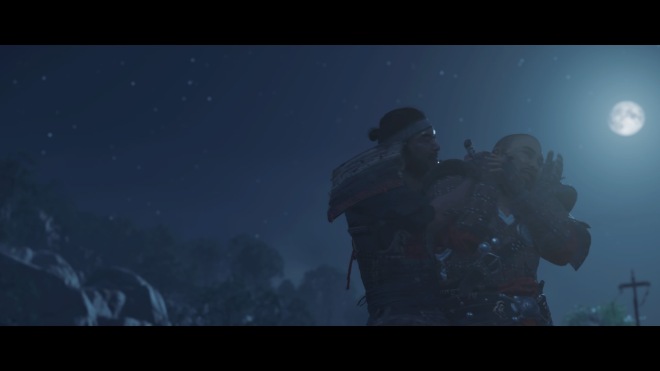
(Image Source: @NateFreelance)
Side Quests & Exploration –
The side-quests in open-world games are usually seen as filler for me. Very rarely will side-quests be something that I openly enjoy just as much as the main story. Ghost of Tsushima shifts this concept on its head though. The side-quests are filled with tiny details, captivating stories and often are just as interesting as the mainline story. Along with the side-events that occur randomly as you traverse through the land, you’ll often find yourself having played for hours on end chasing foxes, birds and composing haiku without having even progressed a single second in the main story. Ghost of Tsushima’s side-quests are probably the most captivating side-quests I have witnessed in any open-world game ever made.
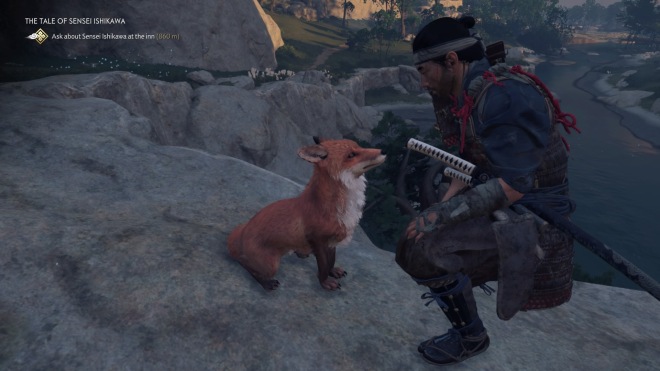
(Image Source: @NateFreelance)
Usually, I am not one for open-world titles. However, the uniqueness of the world of Tsushima in ancient Japan is something that I could not help but be pulled into. The excitement of exploring the landscape. The visuals and general aesthetic of the world are incredible. It is something that allows for this game to have a similar feel to Breath of the Wild. Breath of the Wild being the only other open-world game I have enjoyed. It says a lot for Ghost of Tsushima to bring in that same sense of wonder that Zelda managed to create. I recommend that this game be played in a similar way to Breath of the Wild. Designate time to really sit back and calmly take in the world around you. This game has to be played at a slow pace to really enjoy the experience of the open-world it offers.
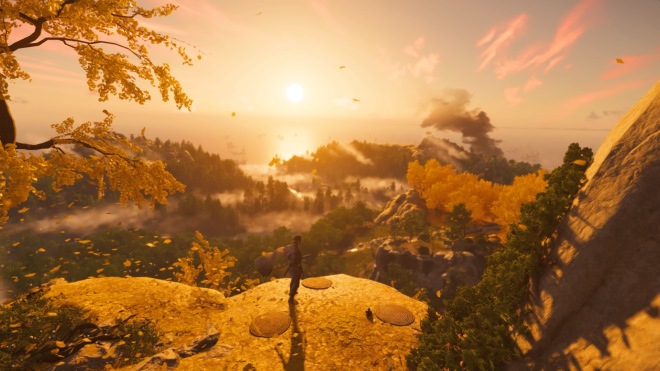
(Image Source: @NateFreelance)
Graphics and Scenery –
As you’ve probably noticed on social media and throughout this article, Ghost of Tsushima is beautiful. Despite not being on the scale of a game like The Last of Us it easily breezes into second place for this generation. The game lets you know the beauty of what you are in for right from the title screen. This title screen of which is one of the best of any video game ever.
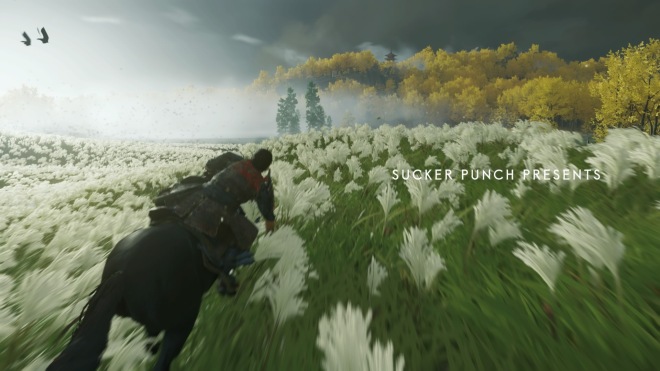
(Image Source: @NateFreelance)
The graphics and level of detail in the game are only amplified by the in-depth photo-mode. If you’ve been anywhere on social media recently you’ll surely have seen hundreds of photos from players sharing the breathtaking view of everything around the island of Tsushima.
Gameplay –
The gameplay was one of my most sceptical aspects of the game prior to release. I was mainly worried about the combat feeling stagnant and slow, however, that is far from the case. Fighting can be a bit random at times due to the lack of a lock-on feature in battles, however, it does not interfere much. Despite the lack of a lock-on system, the combat feels smooth, impactful and generally satisfying. Along the vein of combat, the standoff feature can also be a bit gimmicky. However, it can be incredibly satisfying and awesome feeling to slice multiple enemies in half one by one.
The mass amount of tools and techniques that are at your disposal is something that assists. Each player can approach fights and other areas of the game how they want through these arrays of options that are available.
The movement of Jin is something that can be off too sometimes. When climbing, he can often overshoot jumps and fall to his death. Also, he can often feel very floating when jumping and when moving around the axis whilst sprinting. However, once again, this is not a major problem. Traversal itself via the horse is swift and unlike games like Red Dead Redemption 2, never feels a drag. This is also easily avoided through the vast amount of fast travel points and the load times are something that makes them almost instantaneous.
The Two Genre Defining Innovations of Ghost of Tsushima –
In many ways, Ghost of Tsushima is innovative, yes. However, to me, there would two evidently clear innovations that made the quality of life that much more improved when compared to other open-world titles.
The first of these two innovations is the wind tracking system. The movement towards more immersive open-world experiences has often been clouded by the clunky UI’s that are enforced all over the screen. However, Ghost of Tsushima is one of the first open-world games of its kind to scrap the traditional compass or mini-map and leave almost the entire screen to the disposal of the player’s eyesight.
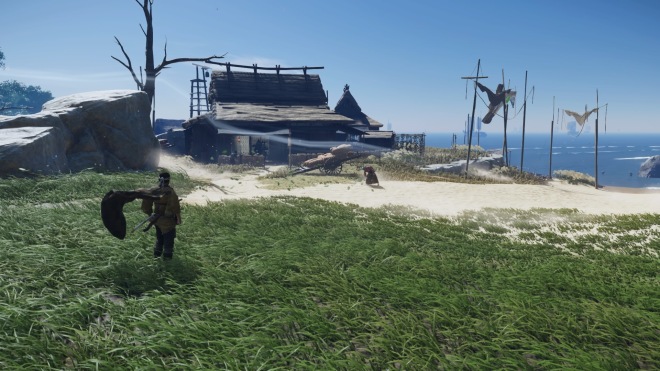
(Image Source: @NateFreelance)
Secondly, the loading times. If you’ve ever played titles such as Horizon: Zero Dawn, you will know how painful modern loading screens can be. Despite being one of the largest and most ambitious open-world games of its time, Ghost of Tsushima has incomprehensibly quick load times. I have become so accustomed to checking my phone in between loading screens. However, Ghost of Tsushima’s are so fast that you barely have time to unlock your phone before you’ve arrived on the other side of the map. This was not something I expected but was rather blown away by. It is especially impressive on the current-gen hardware. It almost seems impossible.
Nit-Picks of the Game and Where it Could Have Improved –
I have struggled to find any faults whatsoever with Ghost of Tsushima. However, this is not to say the game is perfect, as no game ever can be. These select few things mentioned are more nit-picks than anything. Along with this, I have one or two suggestions as to ways the game could have improved. As previously mentioned, the lack of a lock-on system in combat is something that is not needed but would be a significant quality of life improvement when it comes to making the combat more precise and fluid than it already is. A little thing I noticed is the screen fading to black in some scenarios. This is rather than showing the events that take place, such as that of some missions early on with Ryuzo.
As well as these slight complaints, there is also an idea that I feel would have made the game a lot more of a specific-to-the-player experience. The addition of a system like in the Fable games where depending on how you approach the game and the style you choose to play in, your character will change. For example, your decisions in your actions will make you more of a samurai or a ghost as the game progresses. I feel this would have gone a long way in making each playthrough more unique between each individual. Along with this, some slight changes to movement when climbing and accuracy and I think this game would have been the most perfect experience it could have been.
Conclusion –
Finally, Ghost of Tsushima is one of the most ambitious and captivating open-world experiences a gamer can have. As a self-proclaimed disliker of the open-world genre, I can say that Ghost of Tsushima was a rare occasion that I am completely drawn into the world of an open-world game. Despite a few quality of life improvements, the game is almost flawless in everything it tries to do. It is a visual and technical marvel that everyone should experience as the PS4 draws its final breath.
Score – 8/10
